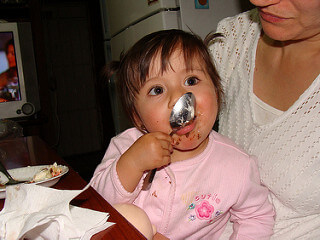Nobody Tells You How Difficult Weaning Is

Weaning your baby off breastmilk is a delicate process, which you should undertake gradually. It requires patience and love.
The end of breastfeeding does not mean the end of the intimate, loving bond that you have built with your baby.
Weaning is just the start of a new form of feeding, and a new stage for your relationship with your child.
Breastmilk contains all the fats, proteins and vitamins that a newborn needs. To maximize the health benefits, experts recommend breastfeeding for at least the first 6 months of your baby’s life.
When we breastfeed our babies, we are not just feeding them. We are also giving them hydration, and strengthening their immune system against hundreds of diseases.
What’s more, the physical contact that we have with our babies during breastfeeding strengthens the bond of love between us.
My world is round, round and soft like yours. And I give it to you so you can dream, so you can fight, so you can create.
Our home is small, our clothes are humble, but in my warm milk, I give you my world.
–Via Lactea (Milky Way), a Spanish breastfeeding organization
What is weaning?
The transition from breastfeeding to other types of food is known colloquially as “weaning.” Weaning does not just involve substituting other foods for breastmilk in your baby’s diet. It is a process that can be emotionally bruising.
The start of weaning may occur for various reasons. It may be that the mother decides to do it, or the baby loses interest in breastfeeding. Sometimes the mother’s milk production is insufficient, or drops off naturally over time.
Whatever the situation, the weaning process can be difficult for both of you, so it’s best to be prepared.
When and how should I begin weaning?

There is no set date to begin weaning. However, some specialists recommend doing it gradually before your child’s first birthday.
One method that is often recommended is reducing the length of feeds, while also introducing other types of food. Some parents have good results giving their baby solid foods during the daytime, continuing to breastfeed only at night.
It is important to speak to a pediatrician about the best way to wean your baby. They will help you with the transition process, so that you can gradually introduce different types of food to ensure a balanced diet for your child.
Advantages of weaning
Although it can be a struggle for both mother and baby, weaning brings a number of emotional and nutritional benefits.
Once your baby is able to eat something other than breastmilk, you can feel confident leaving them with other people. This is important if you have to go back to work, or even just to take a break or run errands.
During the weaning period, your baby will get valuable nutrients from the other foods that you incorporate into their diet. At the same time, they continue to receive protection against disease from your breastmilk.
Tips for weaning

There are many ways to begin weaning in a conscious and respectful way, so that both mother and baby can get through it with as little trauma as possible.
- The process should be flexible. It should never happen suddenly, from one day to the next: you should ideally take about two or three months to fully wean your baby off breastmilk.
- If you don’t go about this process gradually, you are likely to suffer undesirable effects such as hardness and pain in your breasts.
- Try not to begin to wean your baby at a stressful time, such as your first weeks back at work or when your child is starting nursery.
- Before breastfeeding your child, try offering them other kinds of food, so that they can get used to the flavors and textures.
- Babies need patience and affection during the weaning process. Be kind when you offer them food.
Even though you are no longer holding your child in your arms and nursing them constantly, the bond between you never dies. Every mother and baby is unique, so only you will know exactly when and how to go about this process.
Weaning is another one of nature’s wonderful secrets for you to discover.
Weaning your baby off breastmilk is a delicate process, which you should undertake gradually. It requires patience and love.
The end of breastfeeding does not mean the end of the intimate, loving bond that you have built with your baby.
Weaning is just the start of a new form of feeding, and a new stage for your relationship with your child.
Breastmilk contains all the fats, proteins and vitamins that a newborn needs. To maximize the health benefits, experts recommend breastfeeding for at least the first 6 months of your baby’s life.
When we breastfeed our babies, we are not just feeding them. We are also giving them hydration, and strengthening their immune system against hundreds of diseases.
What’s more, the physical contact that we have with our babies during breastfeeding strengthens the bond of love between us.
My world is round, round and soft like yours. And I give it to you so you can dream, so you can fight, so you can create.
Our home is small, our clothes are humble, but in my warm milk, I give you my world.
–Via Lactea (Milky Way), a Spanish breastfeeding organization
What is weaning?
The transition from breastfeeding to other types of food is known colloquially as “weaning.” Weaning does not just involve substituting other foods for breastmilk in your baby’s diet. It is a process that can be emotionally bruising.
The start of weaning may occur for various reasons. It may be that the mother decides to do it, or the baby loses interest in breastfeeding. Sometimes the mother’s milk production is insufficient, or drops off naturally over time.
Whatever the situation, the weaning process can be difficult for both of you, so it’s best to be prepared.
When and how should I begin weaning?

There is no set date to begin weaning. However, some specialists recommend doing it gradually before your child’s first birthday.
One method that is often recommended is reducing the length of feeds, while also introducing other types of food. Some parents have good results giving their baby solid foods during the daytime, continuing to breastfeed only at night.
It is important to speak to a pediatrician about the best way to wean your baby. They will help you with the transition process, so that you can gradually introduce different types of food to ensure a balanced diet for your child.
Advantages of weaning
Although it can be a struggle for both mother and baby, weaning brings a number of emotional and nutritional benefits.
Once your baby is able to eat something other than breastmilk, you can feel confident leaving them with other people. This is important if you have to go back to work, or even just to take a break or run errands.
During the weaning period, your baby will get valuable nutrients from the other foods that you incorporate into their diet. At the same time, they continue to receive protection against disease from your breastmilk.
Tips for weaning

There are many ways to begin weaning in a conscious and respectful way, so that both mother and baby can get through it with as little trauma as possible.
- The process should be flexible. It should never happen suddenly, from one day to the next: you should ideally take about two or three months to fully wean your baby off breastmilk.
- If you don’t go about this process gradually, you are likely to suffer undesirable effects such as hardness and pain in your breasts.
- Try not to begin to wean your baby at a stressful time, such as your first weeks back at work or when your child is starting nursery.
- Before breastfeeding your child, try offering them other kinds of food, so that they can get used to the flavors and textures.
- Babies need patience and affection during the weaning process. Be kind when you offer them food.
Even though you are no longer holding your child in your arms and nursing them constantly, the bond between you never dies. Every mother and baby is unique, so only you will know exactly when and how to go about this process.
Weaning is another one of nature’s wonderful secrets for you to discover.
All cited sources were thoroughly reviewed by our team to ensure their quality, reliability, currency, and validity. The bibliography of this article was considered reliable and of academic or scientific accuracy.
- Vandale-Toney, S., Rivera-Pasquel, M. E., KAGEYAMA-ESCOBAR, M. D. L. L., Tirado-Gómez, L. L., & López-Cervantes, M. (1997). Lactancia materna, destete y ablactación: una encuesta en comunidades rurales de México. Salud Pública de México, 39, 412-419. https://www.scielosp.org/article/spm/1997.v39n5/412-419/
- Klein, M. (1936). El destete. Obras completas de M. Klein.
- La lactancia materna de madre a madre. Lactando.org. 2018. http://www.lactando.org/wp-content/uploads/Lactando_Capitulo-22.pdf
- María Marlen Avalos González, C. (2011). Comportamiento de algunos factores biosociales en la lactancia materna en los menores de un año. Revista Cubana de Medicina General Integral
- Rosa Niño, M., Gioconda Silva, E., & Eduardo Atalah, S. (2012). Factores asociados a la lactancia materna exclusiva. Revista Chilena de Pediatria. https://scielo.conicyt.cl/scielo.php?script=sci_arttext&pid=S0370-41062012000200007&lng=en&nrm=iso&tlng=en
This text is provided for informational purposes only and does not replace consultation with a professional. If in doubt, consult your specialist.








